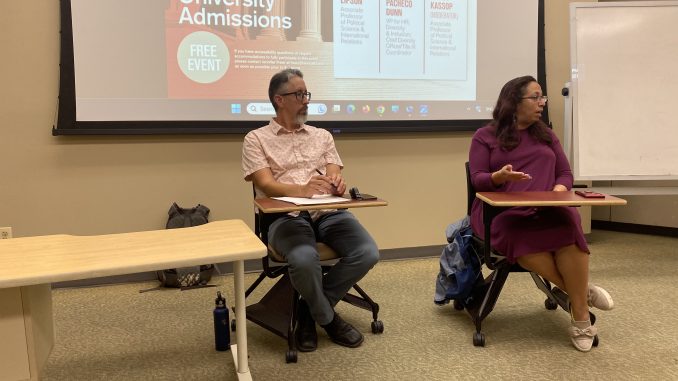
SUNY New Paltz hosted an event called “Making Sense of the Supreme Court’s Decision on Affirmative Action in University Admissions” in the Lecture Center on Wednesday, Sept. 20. The panel and Q&A’s focus was on affirmative action and the broader implications of the landmark Supreme Court decision last June which ruled the consideration of race in college applications unconstitutional.
The panel was moderated by Nancy Kassop, a SUNY New Paltz associate professor of political science and international relations. Panelists were New Paltz assistant professor of political science and international relations Daniel Lipson along with New Paltz Vice President of Human Resources and Diversity & Inclusion Tanhena Pacheco Dunn. Dunn also serves as Chief Diversity Officer/Title IX coordinator for SUNY New Paltz. The panel was hosted by the university in honor of Constitution Day. “We chose a topic of comparative affirmative action for this year’s event, because of the direct impact it has on educational institutions such as New Paltz,” said Kassop. “[Institutions] now need to navigate this new legal landscape to find ways to continue their longtime commitment to a diverse student population in the face of most dramatically changed circumstances.”
Lipson described the history of affirmative action as legislation following the Civil Rights movement which sought to ameliorate the persistent effect of racism on minorities who have been historically subjected to hatred and discrimination. Controversial since its inception, affirmative action has been adopted in myriad variations in U.S. education, corporations and military. The underlying rationale is that diversity benefits both minorities and the overall population. Despite resistance from conservatives, it has previously been upheld in multiple Supreme Court decisions, until the Court’s decision on Students for Fair Admissions V. Harvard in June 2023.
Dunn elaborated on the use of affirmative action in university admissions. According to Dunn, affirmative action is not so relevant to many US public institutions where acceptance rates are high, but becomes more relevant in elite schools, as well as schools whose states contain clusters of underrepresented or marginalized populations. Affirmative action in these circumstances is used by admissions officers to do what Dunn called “shaping a class”: choosing applicants on the basis of race to increase the class’s diversity. Dunn cited that the previous affirmative action program increased diversification by 20% to 30%.
Lipson questioned the enforceability of the Court’s decision. Lipson said “You’re an admissions officer. You have access to the name of the high school that this person went to. You think you don’t know that that one high school is 95% black? You think you don’t know that that high school is 99% white? You will know, if you’re an admissions officer. Second, you get to see the name of the application and you can tell race simply by the name of some applicants. Some it’s very vague, but some it’s absolutely clear. Third, people write about important parts of their life in their personal statement. How do you think that some of them aren’t going to write about race?”
The panelists discussed how the elimination of affirmative action in university admissions has wider implications throughout the U.S. education system. According to Lipson, the Educational Opportunity Program, which claims it is race-neutral but produces a substantial number of Black and brown college students, may be vulnerable to lawsuits now because of the Court’s decision. The panelists said race-based scholarships may also be affected.
